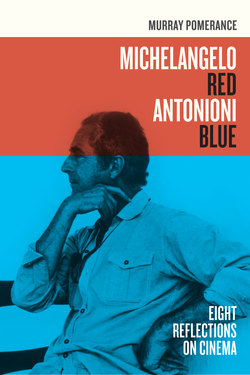Читать книгу Michelangelo Red Antonioni Blue - Murray Pomerance - Страница 11
На сайте Литреса книга снята с продажи.
ОглавлениеOn the Images in This Book
Acknowledging the splendid frontispieces made for all the volumes of that edition by Mr. Alvin Langdon Coburn, in his preface to the 1909 Scribner’s edition of The Golden Bowl, Henry James argued for the sort of image that might “plead its case with some shyness.” My desire in finding a way to illustrate this book was to go still further, with images that might each, in an idiosyncratic way, summon up the whole tenor or tension evoked by the poetry of a film while at the same time drawing into recollection the unfolding argument of this writer’s prose. Michelangelo Antonioni’s color films are complex and monumental structures, and finding the “right” image for each was a project with problems. Conventional publicity stills, for example, are made to highlight either action—not always at the heart of my analysis—or principal actors in character (so as to publicize their work quite as much as the film itself). These shots are therefore typically repetitive for any film, inspirations for my fear that the reader would in most cases have come across them, or very similar images, before. The canonical reading of Antonioni’s works tends toward gender relations in a time of modernist alienation, and one will have trouble scouting through publicity stills if one wishes to find brilliant and evocative images that do not bark this now worn (if not, indeed, misconstrued) theme. Further, many publicity shots are technically altered for color, in order to reproduce well in newsprint. And still worse, many of the shots typify filmic moments vaguely but do not actually represent what we ever precisely see onscreen. To make matters more painful, if more painful they can be: with some of the films included in this book there are virtually no usable publicity images in existence.
Thus I have turned to digital frame enlargements, which permit a very precise selection of moments and a sharply focused attention to the exact nuances of color and composition in any image. Our decisions in printing the images as they are to be found here were made with a view to heightening their sense of color and form, and to getting the best possible reproduction given the necessarily variant and restrictive limits of the originating materials. One image is worth a special word, and that is the illustration for The Mystery of Oberwald, plate 8. This film was produced originally for Radiotelevisione Italiana using an electronic—not a cinematic—recording process, and the resultant film was later transferred to celluloid in Los Angeles, through the now rather outdated process of kinescoping, in which a camera records on film the image that is broadcast in front of its lens on a television screen. Given that Italian television uses a different screen resolution than American television in the first place, even watching the film on TV here would have been a visually degraded experience; but a kinescope makes for a picture that is even softer and imprecise as to color. It is therefore the case that the picture I include, for all its lack of sharpness, really does represent Oberwald as closely as is possible now (there are no sharper publicity stills)—really does hint at the muted and subtly transformational color Antonioni had in mind.
